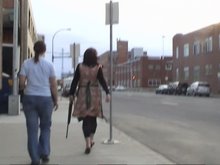All the works to date have utilized various locations in the city as site-specific to their artistic projects. The artists use the city landscape as the medium for artistic research and performance works. Sometimes this frame is deliberately obscured and falls outside our perception of what we assume to mean the city. Assumptions of how to move and encounter the city are implicitly challenged. The preconceived notions of how bodies move through the ephemeral and physical territories demarcating city space are explicitly reconfigured.
I begin to see each artist's project as a network that expands on potential ways of reinventing the city. Emma explores the potential of expanding everyday habitual gestures articulated within the architectural framing of the downtown core of Edmonton. Amber focuses on questioning the tactical and false promises of “free” exchange in the flows of capital and personal relationships. Lori brings to light the alarming problem of disappearing bees as a result of urban sprawl and dwindling green spaces. She brings a playful analysis and solution to the issue by promising to relay messages to the bees.
Nicole re-imagines ways that natural food sources found in the cracks of parking lots and other unexpected urban spaces might be harvested. Juliana and Marc reconfigure the sound ecology of downtown Edmonton by appropriating musak. Josh brings to light the way bodies work to create relation and movement while navigating through various urban environments – from the dance club, the west Edmonton mall to the exercise club. Irene amplifies how social and private drinking generates undercurrents of violence. Jackson 2Bears illuminates strategies of digital expropriation of First Nation's archival history within the form of live urban VJ/DJ culture so prevalent in large metropolitan cities. Tomorrow I will take a walk with Sara and become a flaneur in the streets of Edmonton. On Sunday, I will participate in creating a sustainable garden designed by Nicole.
All these pieces form a mutual parasitic relation to the city. The cityscape mediates the works as much as the works mediate the city. The trace of this relation continues in the extended “digital sprawl”, as Todd so insightfully noted, on the www via the blog and website.
The parasitic relation and strategies exhibited in this festival raise some important questions. What happens when the artists leave the host city? What remains of the events and interventions? A parasite usually exchanges nutrients with the host in order to sustain itself and the host. When the parasite is removed, the host dies. In this case, the artists are concerned about not leaving the landscape depleted of resources as a result of their performances. Rather, there is an intention to produce connections that grow through person contact and accidental encounters that have occurred through the full ten days of the festival. This is made apparent by the tremendous effort everyone is making to generate parasitic links to the blog, so that the works and ideas continue to grow when the festival is offically over.
Subscribe to:
Post Comments (Atom)



No comments:
Post a Comment